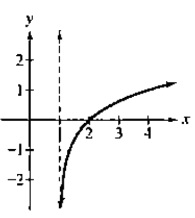Problem 1CVC: 1. is equivalent to the exponential form__________, .
Problem 2CVC: The function f(x)=logbx is the _________ function = with base __________. Problem 3CVC: 3. ________
Problem 4CVC: 4.
Problem 5CVC: logbbx= Problem 6CVC: blogbx= Problem 7CVC: Fill in each blank so that the resulting statement is true.
7. Using interval notation, the domain... Problem 8CVC: Fill in each blank so that the resulting statement is true. The graph of f(x)=log6x approaches, but... Problem 9CVC: Fill in each blank so that the resulting statement is true. The graph of g(x)=5+log2x is the graph... Problem 10CVC: Fill in each blank so that the resulting statement is true.
10. The graph of is the graph of ... Problem 11CVC: Fill in each blank so that the resulting statement is true. The graph of g(x)=log4x is the graph of... Problem 12CVC: Fill in each blank so that the resulting statement is true.
12. The graph of is the graph of ... Problem 13CVC: Fill in each blank so that the resulting statement is true.
13. The domain of can be found by... Problem 14CVC: Fill in each blank so that the resulting statement is true. The logarithmic function with base 10 is... Problem 15CVC: Fill in each blank so that the resulting statement is true. The logarithmic function with base e is... Problem 1E: In Exercises 1-8, write each equation in its equivalent exponential form.
1.
Problem 2E: In Exercises 1-8, write each equation in its equivalent exponential form.
2.
Problem 3E: In Exercises 1-8, write each equation in its equivalent exponential form.
3.
Problem 4E: In Exercises 1-8, write each equation in its equivalent exponential form. 2=log9x Problem 5E: In Exercises 1-8, write each equation in its equivalent exponential form. 5=logb32 Problem 6E: In Exercises 1-8, write each equation in its equivalent exponential form.
6.
Problem 7E: In Exercises 1-8, write each equation in its equivalent exponential form.
7.
Problem 8E: In Exercises 1-8, write each equation in its equivalent exponential form.
8.
Problem 9E: In Exercises 9-20, write each equation in its equivalent logarithmic from.
9.
Problem 10E: In Exercises 9-20, write each equation in its equivalent logarithmic form. 54=625 Problem 11E: In Exercises 9-20, write each equation in its equivalent logarithmic from. 24=116 Problem 12E: In Exercises 9-20, write each equation in its equivalent logarithmic form. 53=1125 Problem 13E: In Exercises 9-20, write each equation in its equivalent logarithmic form.
13.
Problem 14E: In Exercises 9-20, write each equation in its equivalent logarithmic form.
14.
Problem 15E: In Exercises 9-20, write each equation in its equivalent logarithmic form. 132=x Problem 16E: In Exercises 9-20, write each equation in its equivalent logarithmic form. 152=x Problem 17E: In Exercises 9-20, write each equation in its equivalent logarithmic form. b3=100 Problem 18E: In Exercises 9-20, write each equation in its equivalent logarithmic form. b3=343 Problem 19E: In Exercises 9-20, write each equation in its equivalent logarithmic form.
19.
Problem 20E: In Exercises 9-20, write each equation in its equivalent logarithmic form.
20.
Problem 21E: In Exercises 21-42, evaluate each expression without using a calculator. log416 Problem 22E: In Exercises 21-42, evaluate each expression without using a calculator. log7 49 Problem 23E: In Exercises 21-42, evaluate each expression without using a calculator. log2 64 Problem 24E: In Exercises 21-42, evaluate each expression without using a calculator. log3 27 Problem 25E: In Exercises 21-42, evaluate each expression without using a calculator.
25.
Problem 26E: In Exercises 21-42, evaluate each expression without using a calculator.
26.
Problem 27E: 27.
In Exercises 21-42, evaluate each expression without using a calculator.
Problem 28E: In Exercises 21-42, evaluate each expression without using a calculator. log319 Problem 29E: In Exercises 21-42, evaluate each expression without using a calculator. log77 Problem 30E: In Exercises 21-42, evaluate each expression without using calculator.
30.
Problem 31E: In Exercises 21-42, evaluate each expression without using a calculator. log212 Problem 32E: In Exercises 21-42, evaluate each expression without using a calculator. log313 Problem 33E: In Exercises 21-42, evaluate each expression without using a calculator. log64 8 Problem 34E: In Exercises 21-42, evaluate each expression without using a calculator. log81 9 Problem 35E: In Exercises 21-42, evaluate each expression without using a calculator. logs5 5 Problem 36E: In Exercises 21-42, evaluate each expression without using a calculator.
36. log11 11
Problem 37E: In Exercises 21-42, evaluate each expression without using calculator. log4 1 Problem 38E: In Exercises 21-42, evaluate each expression without using a calculator.
38. log6 1
Problem 39E: In Exercises 21-42, evaluate each expression without using a calculator. log5 57 Problem 40E: In Exercises 21-42, evaluate each expression without using calculator. log446 Problem 41E: In Exercises 21- 42, evaluate each expression without using calculator. 8logx19 Problem 42E: In Exercises 21- 42, evaluate each expression without using calculator. 7log723 Problem 43E: Graph f(x)=4x and g(x)=log4x in the same rectangular coordinate system. Problem 44E: Graph f(x)=5x and g(x)=log5x in the same rectangular coordinate system. Problem 45E: Graph f(x)=(12)x and g(x)=log(12)x in the same rectangular coordinate system. Problem 46E: 16. Graph and in the same rectangular coordinate system.
Problem 47E: In Exercises 47-52, the graph of a logarithmic function is given. Select the function for each graph... Problem 48E: In Exercises 47-52, the graph of a logarithmic function is given. Select the function for each graph... Problem 49E: In Exercises 47-52, the graph of a logarithmic function is given. Select the function for each graph... Problem 50E: In Exercises 47-52, the graph of a logarithmic function is given. Select the function for each graph... Problem 51E: In Exercises 47-52, the graph of a logarithmic function is given. Select the function for each graph... Problem 52E: In Exercises 47-52, the graph of a logarithmic function is given. Select the function for each graph... Problem 53E: In Exercises 53-58, begin by graphing f(x)=log2(x+1) . Then use transformations of this graph to... Problem 54E: In Exercises 53-58, begin by graphing f(x)=log2x . Then use transformations of this graph to graph... Problem 55E Problem 56E Problem 57E: In Exercises 53-58, begin by graphing f(x)=log2x. Then use transformations of this graph to graph... Problem 58E Problem 59E Problem 60E: The figure shows the graph of . In Exercises 59-64, use transformations of this graph to graph each... Problem 61E: The figure shows the graph of f(x)=logx . In Exercises 59-64 use transformations of this graph to... Problem 62E Problem 63E Problem 64E Problem 65E: The figure shows the graph of . In Exercises 65-74, use transformations of this graph to graph each... Problem 66E Problem 67E Problem 68E Problem 69E: The figure shows the graph of f(x)=lnx . In Exercises 65-74, use transformations of this graph to... Problem 70E Problem 71E: The figure shows the graph of f(x)=lnx . In Exercises 65-7, use transformations of this graph to... Problem 72E Problem 73E: The figure shows the graph of f(x)=lnx . In Exercises 65-74, use transformations of this graph to... Problem 74E Problem 75E: In Exercises 75-80, find the domain of each logarithmic function.
75.
Problem 76E: In Exercises 75-80, find the domain of each logarithmic function. f(x)=log5(x+5) Problem 77E: In Exercises 75-80, find the domain of each logarithmic function. f(x)=log(2x) Problem 78E: In Exercises 75-80, find the domain of each logarithmic function. f(x)=log(7x) Problem 79E: In Exercises 75-80, find the domain of each logarithmic function. f(x)=ln(x2)2 Problem 80E: f(x)=ln(x7)2 Problem 81E: log 100 Problem 82E: In Exercises 81-100, evaluate or simplify each expression without using a calculator. log 1000 Problem 83E: In Exercises 81-100, evaluate or simplify each expression without using a calculator. log 107 Problem 84E: 84. log 108
Problem 85E: 85. 10 log 33
Problem 86E: 86. 10 log 53
Problem 87E: 87. In 1
Problem 88E: 88. In e
Problem 89E: In e6 Problem 90E: In e7 Problem 91E: ln1e6 Problem 92E: In Exercises 81-100, evaluate or simplify each expression without using a calculator. ln1e7 Problem 93E: In Exercises 81-100, evaluate or simplify each expression without using a calculator.
93. e In 125 ... Problem 94E: In Exercises 81-100, evaluate or simplify each expression without using a calculator. e In 300 Problem 95E: In Exercises 81-100, evaluate or simplify each expression without using a calculator.
95. In e9x
Problem 96E: In Exercises 81-100, evaluate or simplify each expression without using a calculator. In e13x Problem 97E: In Exercises 81-100, evaluate or simplify each expression without using a calculator.
97.
Problem 98E: In Exercises 81-100, evaluate or simplify each expression without using a calculator. eln7x2 Problem 99E: In Exercises 81-100, evaluate or simplify each expression without using a calculator. 10logx Problem 100E: In Exercises 81-100, evaluate or simplify each expression without using a calculator. 10logx3 Problem 101E: In Exercises 101-104, write each equation in its equivalent exponential form. Then solve for x.... Problem 102E Problem 103E Problem 104E Problem 105E: In Exercises 105-108, evaluate each expression without using a calculator.
105. log3(log7 7)
Problem 106E Problem 107E Problem 108E Problem 109E: In Exercises 109-112, find the domain of each logarithmic function. f(x)=ln(x2x2) Problem 110E Problem 111E Problem 112E Problem 113E: The percentage of adult height attained by a girl who is x years old can be modeled by... Problem 114E: The percentage of adult height attained by a girl who is x years old can be modeled by... Problem 115E: 115. The function
models the wives' weekly housework hours, f(x). x years after 1964.
a. Use the... Problem 116E: The bar graph shows the average number of hours per week that U.S. wives and husbands engaged in... Problem 117E: The loudness level of a sound, D, in decibels, is given by the formula
where 1 is the intensity of... Problem 118E: The loudness level of a sound, D. in decibels, is given by the formula D=10log(1012I), where 1 is... Problem 119E Problem 120E Problem 121E: What question can be asked to help evaluate log3 81? Problem 122E Problem 123E: 123. Describe the following property using words:
Problem 124E Problem 125E Problem 126E Problem 127E: 127. Suppose that a girl is 4 feet 6 inches at age 10. Explain how to use the function in Exercises... Problem 128E Problem 129E Problem 130E Problem 131E Problem 132E Problem 133E Problem 134E Problem 135E Problem 136E Problem 137E Problem 138E Problem 139E Problem 140E Problem 141E Problem 142E Problem 143E Problem 144E Problem 145E Problem 146E Problem 147E Problem 148E Problem 149E Problem 150E Problem 151E Problem 152E format_list_bulleted



 College Algebra (MindTap Course List)AlgebraISBN:9781305652231Author:R. David Gustafson, Jeff HughesPublisher:Cengage LearningAlgebra & Trigonometry with Analytic GeometryAlgebraISBN:9781133382119Author:SwokowskiPublisher:Cengage
College Algebra (MindTap Course List)AlgebraISBN:9781305652231Author:R. David Gustafson, Jeff HughesPublisher:Cengage LearningAlgebra & Trigonometry with Analytic GeometryAlgebraISBN:9781133382119Author:SwokowskiPublisher:Cengage Algebra and Trigonometry (MindTap Course List)AlgebraISBN:9781305071742Author:James Stewart, Lothar Redlin, Saleem WatsonPublisher:Cengage Learning
Algebra and Trigonometry (MindTap Course List)AlgebraISBN:9781305071742Author:James Stewart, Lothar Redlin, Saleem WatsonPublisher:Cengage Learning College AlgebraAlgebraISBN:9781305115545Author:James Stewart, Lothar Redlin, Saleem WatsonPublisher:Cengage Learning
College AlgebraAlgebraISBN:9781305115545Author:James Stewart, Lothar Redlin, Saleem WatsonPublisher:Cengage Learning
 Trigonometry (MindTap Course List)TrigonometryISBN:9781337278461Author:Ron LarsonPublisher:Cengage Learning
Trigonometry (MindTap Course List)TrigonometryISBN:9781337278461Author:Ron LarsonPublisher:Cengage Learning




